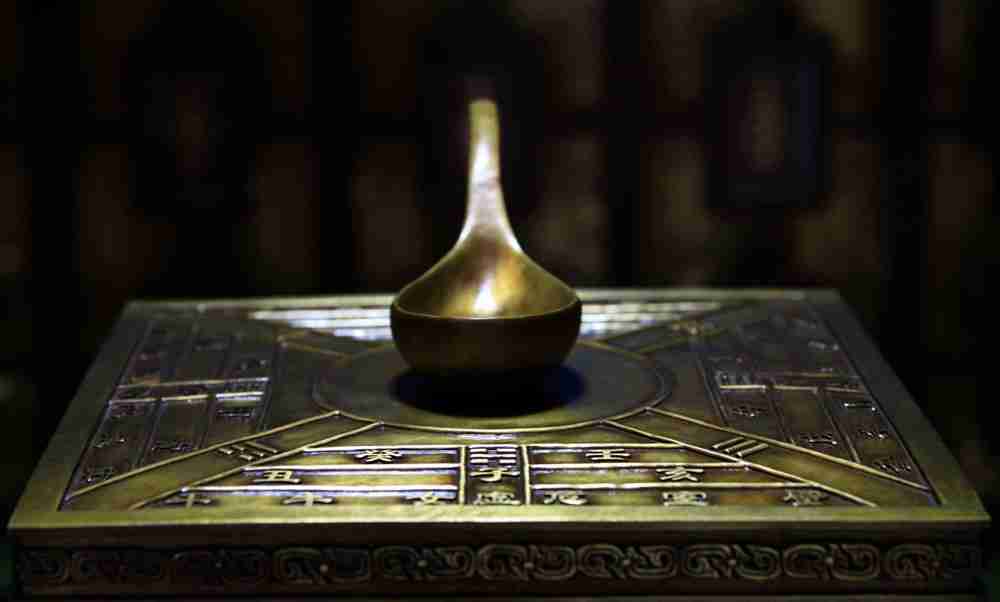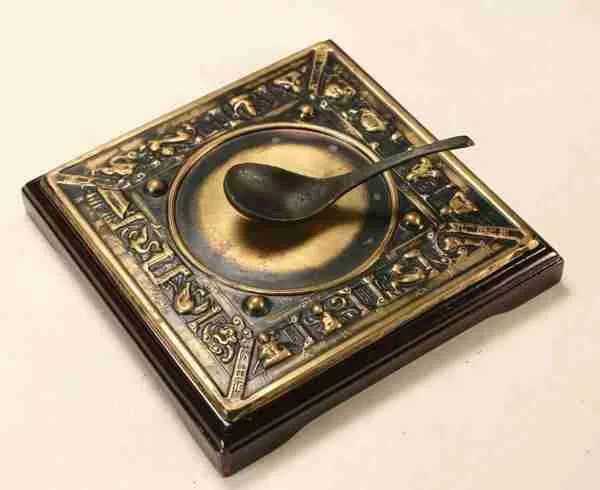The “Si Nan” is an ancient Chinese instrument used for determining directions. It is an invention by the laboring people of the Han ethnic group in ancient China, developed through long-term practical experience in understanding the magnetic properties of objects. According to the records in “Gu Kuang Lu,” it is documented to have first appeared in the region around Mount Ci in Hebei during the Warring States period.
what is Sinan compass
According to “Guiguzi,” it is recorded that when the Zheng people acquire jade, they must carry a “Si Nan” carriage to avoid confusion. According to “Lunheng,” the “Si Nan” scoop, when thrown on the ground, points south when it comes to rest.

As documented in “Pingzhou Ketan,” compass needles were also used on ships. A single needle in the middle points south, while the end pointing north is labeled as south, creating a mutual opposition between north and south. Writing remains unchanged when done on the needle because the Earth’s magnetic south, north, and the magnetic poles on the Earth’s surface do not coincide globally. The strength of the magnetic field varies in different locations, leading to variations in the orientation of the “Si Nan.”
The “Si Nan” is considered the earliest magnetic directional indicator in the world, originating in the Warring States period (475–221 BCE) and continuing until the Tang Dynasty (618–907 CE). The ancient Chinese compass was primarily used for navigation, geodetic surveying, travel, and military purposes, making a significant contribution to global civilization. Although some attribute the discovery of magnetic declination to Shen Kuo, the “Si Nan” from the Warring States period already had records of using the Earth’s magnetic field for orientation.
The “Si Nan” consists of a “scoop” made of a magnetic stone and a “plate.” The scoop can freely rotate, and when it stops, the handle points south. The plate, made of copper, has degree markings around its edges, with a slight elevation in the center. When the scoop stops rotating, the direction indicated by the handle is the south. During use, the markings on the plate need to be aligned with the position indicated by the handle.
After its invention, the “Si Nan” found widespread use in civilian and military navigation. In civilian applications, it was used in fields such as feng shui, divination, and calligraphy. In military applications, it played a role in strategic layout and battlefield tactics. In navigation, it was employed for geographical orientation. Records indicate that as early as the Han Dynasty, navigation used the “Si Nan” to determine direction. Later, the compass became more prevalent in navigation after the Song Dynasty, as documented in “Pingzhou Ketan.”
During the Ming Dynasty, Zheng He’s voyages to the West already employed the compass. According to “Xiyang Fanguo Zhi,” Zheng He’s fleet used various exquisite instruments, including compasses, on their journeys. In the late Ming and early Qing Dynasties, missionaries introduced European astronomical knowledge to Chinese officials. During the Kangxi era, a brass imperial “South-pointing Turtle” was manufactured for maritime use. With the guidance of missionary Johann Adam Schall von Bell, a woodcut “South-pointing Turtle” was later produced with finer craftsmanship. As Western missionaries increased their activities in China and Western culture spread, the woodcut “South-pointing Turtle” gradually transitioned from the imperial court to the general population, becoming known as the “wooden compass” in everyday use.
As Western culture spread and technology advanced, the “wooden compass” was gradually replaced by brass to prevent corrosion and moisture damage, offering enhanced durability and aesthetics. With increased missionary activities in China, the brass compass became commonplace and an essential tool for navigation. As China’s influence expanded globally, the brass compass ventured beyond its borders. However, with the development of the Industrial Revolution in Europe and advancements in science and technology, the brass compass was eventually replaced by steel, surpassing its predecessor in material strength.
who invented sinan compass
The invention of the “Si Nan” (South-pointing instrument) has been a subject of historical debate, with two main perspectives attributing its creation to either the legendary figure Huangdi (Yellow Emperor) of the Xuan Yuan period or the renowned astronomer Zhang Heng from the Han Dynasty. Below, we will provide a detailed analysis and discussion of these two viewpoints.

Firstly, the notion that Huangdi invented the Si Nan is primarily derived from ancient texts such as “Guiguzi” and “Jiutian Xuannu Qingnang Haijiao Jing.” According to these records, Huangdi, during warfare, required an instrument for directional guidance. Consequently, his officials were tasked with inventing the Si Nan. Initially crafted from naturally occurring magnetic stones, the instrument’s southern pole would point towards the geographic south after grinding and polishing, facilitating direction determination. Some scholars thus contend that the invention of the Si Nan can be traced back to the era of Huangdi.
However, skeptics question this viewpoint, highlighting that the social productivity and technological capabilities during Huangdi’s time were relatively primitive, making it challenging to produce such a precise magnetic directional instrument. Additionally, the earliest Si Nan artifacts unearthed through archaeological excavations date back to the Han Dynasty, a considerable time gap from the era of Huangdi. Consequently, they argue that attributing the invention of the Si Nan to Huangdi may be a legendary tale or a misunderstanding of history.

In contrast, the alternative perspective posits that Zhang Heng, a prominent astronomer of the Han Dynasty, invented the Si Nan. This viewpoint has gained more acceptance and confirmation. Historical records depict Zhang Heng’s remarkable achievements in astronomy, mathematics, and mechanical engineering. His improvements to astronomical instruments, including the armillary sphere, are well-documented. The text “Lunheng” contains references to magnetic directional instruments, further supporting Zhang Heng’s knowledge and capability to invent the Si Nan.
Moreover, archaeological findings from the artifacts of the Han Dynasty include numerous magnetic stones and products, serving as tangible evidence of early magnetic tools. Post-Han Dynasty literature also frequently mentions the application and refinement of the Si Nan, demonstrating its gradual development.
Many people believe that the compass was invented by the ancient Chinese scientist and inventor Shen Kuo. Shen Kuo lived during the Northern Song Dynasty, around the 11th century AD. While the exact inventor of the compass cannot be conclusively determined, Shen Kuo described a scenario of navigating using the compass in his book “Dream Pool Essays” (《梦溪笔谈》). This work is considered a significant document as it provides the first systematic recording of the methods and principles of compass usage.
In conclusion, while historical records regarding the inventor of the Si Nan remain contentious, existing evidence suggests that Zhang Heng, the astronomer from the Han Dynasty, is the most likely creator. His expertise, documented knowledge, and archaeological evidence support this claim. Nevertheless, historical controversies and mysteries persist, prompting ongoing exploration and discovery. Regardless of whether it was Huangdi or Zhang Heng who invented the Si Nan, it is crucial to respect historical facts and evidence, continually explore and uncover more historical truths, and cherish and pass on the technological achievements of ancient civilizations for insights and inspiration in modern scientific development and application.
Sinan Structure
The “Si Nan” is an ancient Chinese invention of the magnetic compass, and its construction is relatively simple, primarily consisting of two parts: the magnetic scoop and the copper plate.
The magnetic scoop is a spoon-shaped object made of a magnetic stone, typically processed from a natural magnet. The handle of the magnetic scoop possesses magnetism, allowing it to indicate direction. On the handle of the magnetic scoop, there is usually a small hole used to secure the magnetic scoop onto the copper plate.
The copper plate is a smooth, circular dish typically made of copper. The surface of the copper plate is very smooth to ensure the free rotation of the magnetic scoop. To stabilize the magnetic scoop on the copper plate, a small protrusion is often set in the center of the copper plate, with the bottom of the magnetic scoop resting on it.
During usage, place the magnetic scoop on the copper plate, allowing it to rotate freely. Due to the Earth’s magnetic field, the handle of the magnetic scoop will point towards the geographical south. When the magnetic scoop comes to a stop, its direction indicates the south.
In addition to the magnetic scoop and copper plate, the “Si Nan” also includes a stand used to secure the copper plate on a stable surface. The stand is typically made of wood or metal, and its height can be adjusted to facilitate the use of the “Si Nan” in different terrains and environments.
how sinan compass works
The working principle of the “Si Nan” is based on the interaction between the Earth’s magnetic field and magnetic materials. The Earth acts as a large magnet, with its magnetic south pole near the geographic north pole and its magnetic north pole near the geographic south pole. The magnetic south pole (S pole) of a magnet is ground into a long handle, placed on a smooth, bronze plate that is cast with directional markings. Using naturally magnetized iron ore, shaped like a scoop, placed on a smooth plate engraved with directional markings, the magnetic properties of the material interact with the Earth’s magnetic field, allowing for the identification of directions, serving as the precursor to the modern compass.
The “Si Nan” is composed of two parts: the magnetic scoop and the copper plate. The magnetic scoop is made of natural magnetite and typically has a spoon-shaped form with magnetic properties. The copper plate is a smooth, circular dish used to hold the magnetic scoop. When the magnetic scoop is placed on the copper plate, the handle of the magnetic scoop points towards the Earth’s magnetic south pole due to the influence of the Earth’s magnetic field.
As the magnetic scoop is positioned on the copper plate, the magnetic forces cause it to rotate in alignment with the Earth’s magnetic field, indicating the geographic south pole. This magnetic orientation is the core principle behind the functionality of the “Si Nan.”
In addition to the magnetic scoop and copper plate, the “Si Nan” includes a stand to secure the copper plate on a stable surface. The height of the stand is adjustable to accommodate usage in different terrains and environments.
how to use sinan compass
The “Si Nan” is an ancient Chinese invention of the magnetic compass, marking the world’s earliest magnetic compass. Its usage is remarkably straightforward, requiring only that the magnetic needle be placed on a smooth surface, allowing it to freely rotate. The south pole of the magnetic needle will then point towards the geographical south. The specific steps for using the “Si Nan” are as follows:
Place the “Si Nan” on a smooth surface, which can be a copper plate, wooden board, or stone surface, ensuring that the magnetic needle can rotate freely without attaching to other objects.
Gently flick the magnetic needle with your fingers to initiate its rotation.
When the magnetic needle comes to a stop, its south pole will point towards the geographical south. This alignment occurs due to the influence of the Earth’s magnetic field, where the magnetic field lines’ south and north poles do not coincide with the magnetic needle’s south and north poles. As a result, the south pole of the magnetic needle aligns with the Earth’s south pole.
In addition to placing it on a smooth surface, the “Si Nan” can also be suspended in the air, known as “hanging needle.” To do this, thread a fine line through the middle of the magnetic needle and suspend it on a stand. Due to the Earth’s rotation and the magnetic field, the magnetic needle will continuously rotate. When it comes to rest, its south pole will point towards the geographical south.
Beyond the magnetic compass, ancient China also had other compass variants like the “water compass” and “land compass.” The water compass was used on ships, relying on a floating compass needle on the water surface to indicate direction. The land compass, on the other hand, was used on land by placing the compass in a bowl filled with water or on a wooden board that could float on the water surface.
In summary, the “Si Nan” is an ancient Chinese invention of the magnetic compass, representing the world’s earliest such device. Its usage is simple, involving placing the magnetic needle on a smooth surface or suspending it in the air, allowing it to freely rotate or continuously rotate until the south pole points towards the geographical south. The “Si Nan” played a crucial role in the development of ancient Chinese navigation, geodetic surveying, and travel. Additionally, it stands as a significant achievement in China’s ancient technological civilization, influencing the history of global technology and human civilization development.
sinan vs compass

Although both the “Si Nan” and the compass are ancient Chinese navigation tools, there are certain differences in their construction, functions, and uses. Below is a detailed comparison of the distinctions between the “Si Nan” and the compass:
Construction and Principles:
Si Nan: Comprised of a magnetic scoop made from a magnetic stone and a copper plate. The magnetic scoop’s handle is magnetic, and when stationary, it points towards the south. The copper plate is rotatable, and when the magnetic scoop is placed on it, the magnetic scoop follows the direction of the Earth’s magnetic field, pointing towards the geographical south.
Compass: Primarily consists of a magnetic needle and a compass rose. The magnetic needle, made of magnetic material, can freely rotate, and when stationary, its north pole points towards the Earth’s north. The compass rose is a circular disc with directional markings, and placing the magnetic needle on it helps determine the direction based on the needle’s orientation.
Functions and Uses:
Si Nan: Mainly used in fields such as feng shui, divination, and calligraphy. Due to its weaker magnetic properties, it requires frequent calibration, making it less suitable for precise navigation, such as in maritime activities.
Compass: Primarily used in navigation, geodetic surveying, and travel. With stronger magnetic properties, it is convenient to use and can quickly and accurately indicate direction. In maritime navigation, the compass is one of the most crucial navigation tools, ensuring the safety and accuracy of navigation.
Influence and Historical Significance:
Si Nan: One of China’s four great inventions, representing the world’s earliest magnetic compass. Its invention significantly influenced the development of ancient Chinese technological civilization and made a vital contribution to human civilization.
Compass: A magnetic compass invented in ancient China, predating Western records of its use by four centuries. The invention and widespread use of the compass had a significant impact on the history of global technology and human civilization development. As China’s maritime activities expanded, the compass gradually spread worldwide, becoming one of the widely used navigation tools in global navigation.
Usage Methods and Precautions:
Si Nan: When using the Si Nan, place the magnetic scoop on a smooth copper plate, allowing it to freely rotate. When the magnetic scoop comes to a stop, its handle points towards the south. It is essential to maintain the smoothness and cleanliness of the copper plate to avoid interference with the rotation of the magnetic scoop.
Compass: When using the compass, place the magnetic needle on the compass rose, allowing it to freely rotate. When the magnetic needle is stationary, its north pole points towards the Earth’s north. It is crucial to protect the magnetic needle and compass rose, avoiding severe vibrations or impacts to maintain the accuracy of the indications.
In conclusion, while both the “Si Nan” and the compass are magnetic compasses invented in ancient China, they differ in construction, functions, historical significance, and usage methods. The Si Nan is primarily used in fields like feng shui and divination, while the compass finds extensive applications in navigation and geodetic surveying. Both represent significant achievements in ancient Chinese technological civilization and have had a profound impact on the history of global technology and human civilization.
Reference Materials:
- Wang Jianping, Wen Renjun. Outline of the History of Chinese Science and Technology. Wuhan: Wuhan University Press, 2012. Pages 256-262.
- “The Four Great Inventions: The Compass.” CCTV. [Accessed on October 22, 2015].